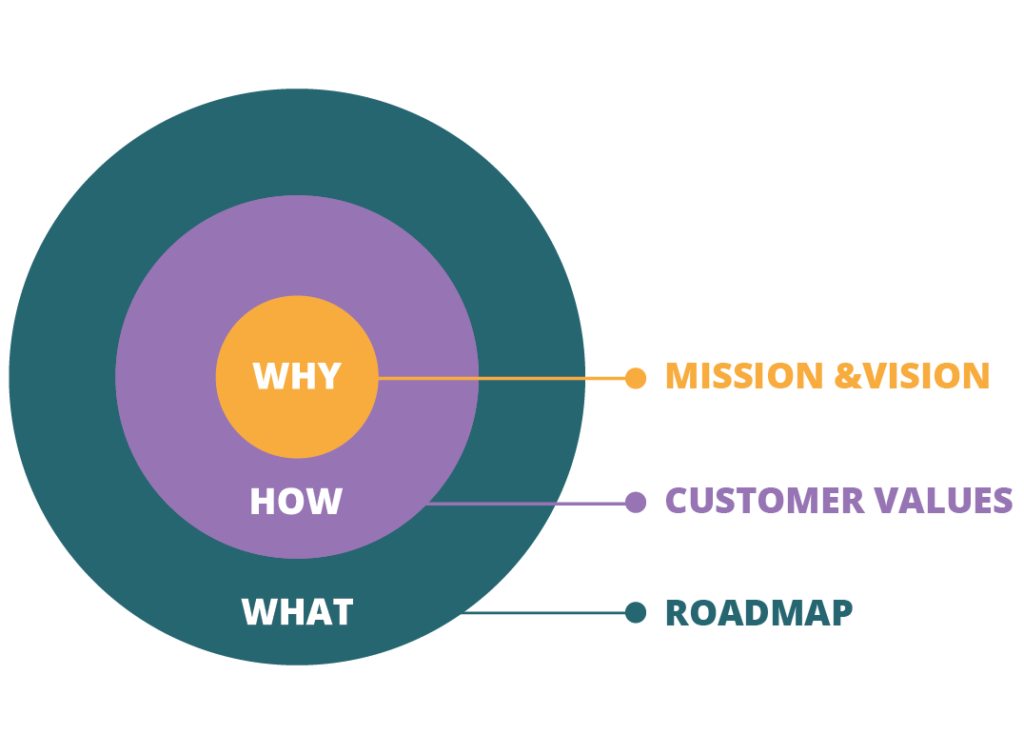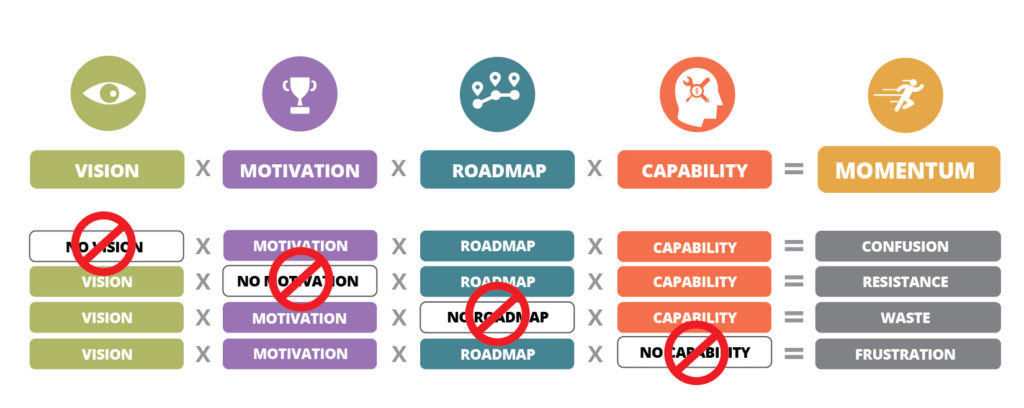Software product momentum follows Isaac Newton’s first law of motion, otherwise known as the law of inertia. Once it gets rolling, it’s hard to stop. You can create momentum for the software products that your firm produces by inspiring the people in your ecosystem, but it is also important to reduce the sources of friction that stand in the way of your vision.
If you work with digital products long enough, you will see all kinds of permutations of friction slowing down product development, stalling momentum, and just plain getting in the way. Let’s look at what it takes to create product momentum and dissect some of the sources of friction so that we may find ways to address them in our strategies.
All of the following components are required to create and sustain software product momentum. We have summed it up with this simple formula:
Vision + Capability + Motivation + Roadmap = Momentum
Vision:
A software product’s vision involves having a unified understanding of who we are serving and a map of their underlying concerns. Once we understand that, we can align our teams around producing a customer journey that results in an advocacy relationship, and we can create a mission statement for our product that our team can connect to. To develop a clear vision for a software product, we leverage Simon Sinek’s Golden Circle, a model for describing how to effectively communicate and connect with your employees and customers by thoroughly answering three questions about our products:

- Begin by focusing on the “why”; the why matters. What is your product mission? Why do you do what you do? A simple and clear mission will align your teams around what change this software product will create in the world of our users.
- Next is the “how”. To understand the how, clearly define what your customers want, what they will truly value in your product. Once you’ve identified their core concerns, you can prioritize how you will create the product, addressing each concern with an innovative solution.
- The final section of Sinek’s model is the “what”. With a clear mission in place and defined customer values, your team can now determine what product you will create to successfully accomplish your mission and provide the value your customers desire.
According to Sun Tzu,
“Strategy without tactics is the slowest path to victory and tactics without strategy is that noise you hear right before defeat.”
When we lack clarity of our vision, it is difficult to remain aligned for long, and we run the risk of losing confidence. Clarity is an important factor in your digital product innovation plan. Without it, you introduce friction from just about every angle. Nothing reduces momentum as fast as confusion.
Motivation:
Motivation comes from having an inspired team that is aligned and unified around the vision. The most powerful strategies are those that are derived by your leadership teams together, making sure that everyone’s opinion and ideas are at least considered, including the bad ones. When everyone is aligned, decisions flow faster and things get done.
Alignment is one of the hardest things to create, but when you have it, the conversations increase and improve, and the organizational collaboration is palpable. Having your team unified around your customers is also critical to motivation. Your customers should drive your business and your business should drive your technology decisions, thus making it crucial to define who are your customers and what it is they care about in the context of doing business with you. First aligning your team around what your customers care about will provide a foundation for getting everyone aligned and motivated around your digital product innovation plan. Without motivation, teams exhibit resistance and apathy.
Roadmap:
When you have a clear roadmap that your team creates and prioritizes together, you have the missing tactics from Sun Tzu’s quote above. When your team can see how the fundamental building blocks of their product will come together, they will remain aligned around the product vision, and will continue to deliver high quality work throughout. The key to a successful roadmap is making healthy short-term and bold long-term commitments. Not keeping your word on these commitments leads to the waste of time and resources that can continue to resonate throughout the product development process.
Capability:
Capability can be summed up as a combination of the right knowledge, skills, tools, and resources. This is possibly the most obvious factor in creating momentum. Without the proper skills and knowledge (or access to knowledge), your team lacks the competence to accomplish. Without the proper capital and the right tools to complete a task, your team will be anxious and lack confidence. The lack of ability and/or resources simply creates a frustrated team. However, with the proper skills, knowledge, and resources at your team’s disposal, there is nothing left to hold the train back.
The Momentum Formula.

To produce momentum, develop a digital product innovation plan that is worthy of your brand, and establish a lean and adaptive strategic framework for future planning that can be used to continuously improve upon and periodically revisit, to keep the organization’s digital assets fresh and powerful, well into the future.
The Continuous Innovation Mindset:
The Continuous Innovation Mindset will help you sustain and even increase momentum throughout the lifecycle of a software product. In the old process of Waterfall, it was common for clients to have an initial meeting with their technology vendor, then not hear from them for days, weeks, months at a time, only to touch base again when there was something to present. You can see how in this model, it is easy for the client to lose momentum and lose trust in their vendor. During these periods, or gaps, where communications are missing, it is all too common for any piece of the momentum formula to fall out. The Continuous Innovation mindset, however, is built to keep momentum high by delivering completed items within a reasonable time-frame, to enforce constant communications and involvement with the client, and to define a clear outline on the evolving and powerful product vision. Without a Continuous Innovation mindset in place that incorporates the four elements above, loss of momentum is a serious side effect.
References:
Sean Flaherty (2016, October 21). Connect: Creating a Mission Statement for Your Software Product.
Simon Sinek (2011, December 27). Start With Why. https://www.amazon.com/Start-Why-Leaders-Inspire-Everyone/dp/1591846447
Sean Flaherty (2014, November 13). 3 Lessons From Sun Tzu for Your Technology.



